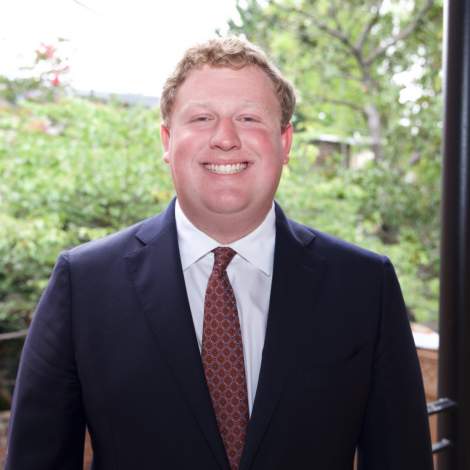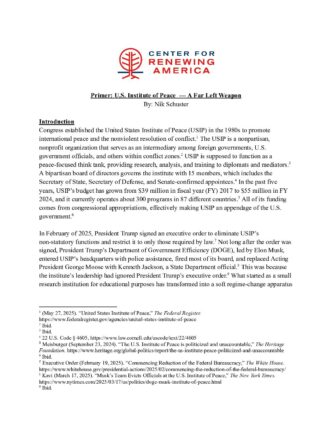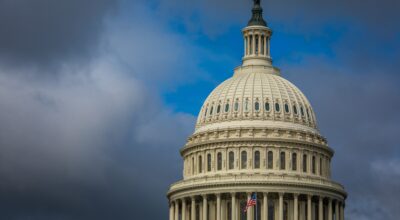
Primer: U.S. Institute of Peace — A Far Left Weapon
Introduction
Congress established the United States Institute of Peace (USIP) in the 1980s to promote international peace and the nonviolent resolution of conflict.1 The USIP is a nonpartisan, nonprofit organization that serves as an intermediary among foreign governments, U.S. government officials, and others within conflict zones.2 USIP is supposed to function as a peace-focused think tank, providing research, analysis, and training to diplomats and mediators.3 A bipartisan board of directors governs the institute with 15 members, which includes the Secretary of State, Secretary of Defense, and Senate-confirmed appointees.4 In the past five years, USIP’s budget has grown from $39 million in fiscal year (FY) 2017 to $55 million in FY 2024, and it currently operates about 300 programs in 87 different countries.5 All of its funding comes from congressional appropriations, effectively making USIP an appendage of the U.S. government.6
In February of 2025, President Trump signed an executive order to eliminate USIP’s non-statutory functions and restrict it to only those required by law.7 Not long after the order was signed, President Trump’s Department of Government Efficiency (DOGE), led by Elon Musk, entered USIP’s headquarters with police assistance, fired most of its board, and replaced Acting President George Moose with Kenneth Jackson, a State Department official.8 This was because the institute’s leadership had ignored President Trump’s executive order.9 What started as a small research institution for educational purposes has transformed into a soft regime-change apparatus that operates under the cover of humanitarianism and outside the control of the people’s elected representatives.
Like many other aspects of the U.S. government, the USIP has become a tool to advance the far left’s agenda. Recently, U.S. District Court Judge Beryl Howell issued a ruling blocking the Trump Administration’s efforts to dismantle USIP, stating that the Administration’s actions were “null and void.”10 Congress should step in and defund USIP entirely during its FY 2026 appropriations process this summer.
A Woke and Weaponized Entity
Despite its so-called nonpartisan mission, the USIP has become a woke and weaponized entity. Some have argued the USIP serves as a back-channel apparatus for bureaucrats in the Intelligence Community and the U.S. State Department.11 For instance, when the U.S. withdrew and the Taliban retook Afghanistan, USIP criticized the Taliban’s ban on opium and declared that it would be “bad for Afghans and the world.”12 Indeed, U.S. taxpayer funds have been used to support irrigation projects in Afghan opium fields and allegedly the narcotics trade as a whole.13 Also, USIP has published numerous white papers indicating support for regime change and color revolutions. For example, the following papers provide potential blueprints on how to coordinate mob action and provide support for regime change efforts internationally:
- From the Street to the Peace Table: Nonviolent Mobilization during Intrastate Peace Processes.14
- Sowing the Seeds of Nonviolent Action in Sudan.15
- Nonviolent Action in Myanmar: Challenges and Lessons for Civil Society and Donors.16
- Nonviolent Action and Transitions to Democracy: The Impact of Inclusive Dialogue and Negotiation.17
At the very least, Congress should investigate the USIP’s role in fomenting regime change and mob action. Furthermore, it is essential to examine how USIP is connected to other non-governmental organizations and government actors that facilitate progressive policy agendas, such as the National Endowment for Democracy (NED) and the United States Agency for International Development (USAID). All three of these entities have played major roles in nations where regime change and color revolutions have taken place, such as Afghanistan, Ukraine, and Myanmar.
USIP’s budget has grown from $39 million in FY 2017 to $55 million in FY 2024, and how that money is spent is largely opaque.18 The 2024 Congressional Budget Justification provides no breakdown of USIP’s spending based on purpose and activities.19 However, DOGE’s efforts to expose woke and weaponized spending at USIP have uncovered some startling revelations. For example, cancelled USIP contracts include:
- $132,000 in payments to Mohammad Qasem Halimi, an ex-Taliban member who was Afghanistan’s former Chief of Protocol.20
- $2,232,500 to an outside accountant, who attempted to delete over one terabyte of accounting data (now recovered) after new leadership entered the building.21
- $1,307,061 to the Al Tadhamun Iraqi League for Youth.22
- $675,000 for private aviation services.23
Additionally, DOGE found that prior management of USIP would sweep excess funds into a private endowment, which lacks congressional oversight, and over the past 10 years, USIP has transferred $13 million to that endowment for private events and air travel.24 This is one of the most extreme forms of waste, fraud, and abuse because it appears that USIP employees were utilizing taxpayer funds for personal benefit. During a Fox News interview with Jesse Waters, one DOGE employee stated that USIP had a cache of loaded guns at the agency headquarters,25 which leads one to question why an institution focused on the resolution of conflict through peaceful means would need a stash of weaponry.
In 2022, a podcast of the USIP discussed the need for diversity, equity, and inclusion in peacebuilding and even articulated that it should be a peacebuilding practice.26 Members of the USIP have participated in panels on diversity, equity, and inclusion hosted by other radical left-wing organizations. For example, Dipali Mukhopadhyay of the USIP participated in an American Society of International Law event called “Issues of Diversity and Inclusion in the Peace Processes.”27 Another USIP publication entitled “Why Gender and Sexual Minority Inclusion in Peacebuilding Matters” attacked so-called patriarchal gender norms. This was simply radical-intersectional feminism cloaked under the guise of peacebuilding.28 It is clear that the USIP does not function as a nonpartisan peace think tank but as an entity designed to carry water for radical left-wing ideologies.
Conclusion
The USIP is another taxpayer-funded left-wing scheme that promotes multiple aspects of the left’s agenda, along with regime change schemes. Congress should make permanent what President Trump and the DOGE team have started by dismantling and completely defunding the entire entity. The President’s FY 2026 budget includes the elimination of USIP, just as past Trump Administration budgets have done. It is past time for Congress to get serious about defunding this woke and weaponized bureaucracy, which is completely at odds with the American people.
Endnotes
1. (May 27, 2025). “United States Institute of Peace,” The Federal Register. https://www.federalregister.gov/agencies/united-states-institute-of-peace
2. Ibid.
3. Ibid.
4. 22 U.S. Code § 4605, https://www.law.cornell.edu/uscode/text/22/4605
5. Meisburger (September 23, 2024). “The U.S. Institute of Peace is politicized and unaccountable,” The Heritage Foundation. https://www.heritage.org/global-politics/report/the-us-institute-peace-politicized-and-unaccountable
6. Ibid.
7. Executive Order (February 19, 2025). “Commencing Reduction of the Federal Bureaucracy,” The White House. https://www.whitehouse.gov/presidential-actions/2025/02/commencing-the-reduction-of-the-federal-bureaucracy/
8. Kavi (March 17, 2025). “Musk’s Team Evicts Officials at the U.S. Institute of Peace,” The New York Times. https://www.nytimes.com/2025/03/17/us/politics/doge-musk-institute-of-peace.html
9. Ibid.
10. Rosen and Quinn (May 19, 2025). “Judge rules Trump administration’s dismantling of U.S. Institute of Peace was illegal,” CBS News. https://www.cbsnews.com/news/trump-administration-dismantling-u-s-institute-of-peace-illegal-judge-rules/
11. https://x.com/RT_com/status/1927416577726570550
12. Byrd (June 8, 2023). “The Taliban’s Successful Opium Ban is Bad for Afghans and the World,” The U.S. Institute of Peace. https://web.archive.org/web/20230920223023/https://www.usip.org/publications/2023/06/talibans-successful-opium-ban-bad-afghans-and-world
13. https://x.com/MikeBenzCyber/status/1927323998703980804?t=5070, https://www.breitbart.com/national-security/2018/06/21/feds-u-s-taxpayer-funds-helping-irrigate-fertilize-afghan-opium-funding-taliban/
14. Dudouet (2021). “From the Street to the Peace Table: Nonviolent Mobilization during Intrastate Peace Processes,” U.S. Institute of Peace. https://www.academia.edu/71962607/From_the_Street_to_the_Peace_Table_Nonviolent_Mobilization_during_Intrastate_Peace_Processes
15. https://www.usip.org
16. La Ring (2020). “Nonviolent Action in Myanmar: Challenges and Lessons for Civil Society and Donors,” U.S. Institute of Peace. https://www.govinfo.gov/app/details/GOVPUB-Y3_P31-PURL-gpo150318
17. Dudouet (2021). “Nonviolent Action and Transitions to Democracy: The Impact and Inclusive Dialogue and Negotiation,” U.S. Institute of Peace. https://www.govinfo.gov/content/pkg/GOVPUB-Y3_P31-PURL-gpo158793/pdf/GOVPUB-Y3_P31-PURL-gpo158793.pdf
18. Meisburger (September 23, 2024). “The U.S. Institute of Peace is politicized and unaccountable,” The Heritage Foundation. https://www.heritage.org/global-politics/report/the-us-institute-peace-politicized-and-unaccountable
19. Ibid.
20. https://x.com/DOGE/status/1906848257705443758?lang=en
21. Ibid.
22. Ibid.
23. Ibid.
24. Ibid.
25. https://www.youtube.com/watch?v=AIOVLLarqjo
26. (October 7, 2022). “Justice, diversity, equity, inclusion and accessibility (JDEIA). What is JDEIA? Listen in to U.S. Institute of Peace,” Black Emergency Managers International. https://www.blackemergmanagersassociation.org/2022/10/justice-diversity-equity-inclusion-and.html
27. (2021). “Issues of Diversity and Inclusion in Peace Processes,” American Society of International Law. https://www.asil.org/events/issues-diversity-and-inclusion-peace-processes
28. Schiwal and Kuehnast (2017). “Why Gender and Sexual Minority Inclusion in Peacebuilding Matters: A growing body of evidence detailing exclusion from overall peacebuilding work suggests there is much left to be done,” U.S. Institute of Peace. https://www.wcaps.org/blog-2/why-gender-and-sexual-minority-inclusion-in-peacebuilding-matters#:~:text=Inclusion%20of%20gender%20and%20sexual%20minorities%20in%20peacebuilding%20efforts%20also,for%20them%20to%20meaningfully%20participate.





